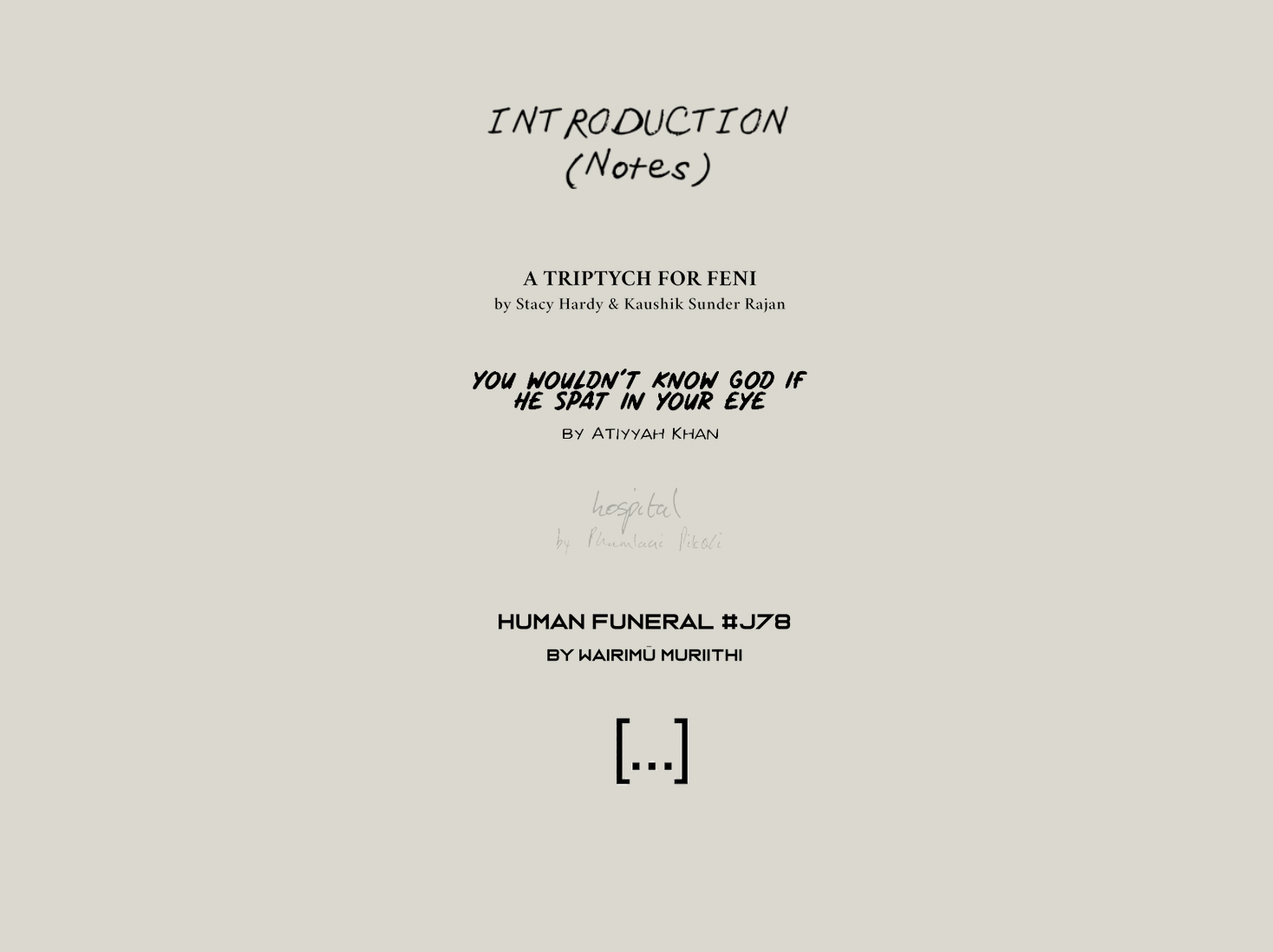
‘You wouldn’t know God if he spat in your eye’: Impressions from Dumile Feni’s Scroll
Ellipses […]: Journal of Creative Research
Stacy Hardy
Kaushik Sunder Rajan
Atiyyah Khan
Phumlani Pikoli
Wairimu Murithi
Contributors
Role
Curator
Programmed for, and published online as part of, Ellipses […]: Journal of Creative Research’s third issue, “Embodied Methodologies,” this project was the culmination of research conducted for an MA in Contemporary Curatorial Practices, supervised by Nontobeko Ntombela and Tegan Bristow.
The project can be accessed here.
It consists of a series of short stories. They are based on each author’s experience of Dumile Feni’s scroll, which spends most of its time wrapped in a padded box in Wits Art Museum’s (WAM) storeroom—a climate-controlled, access-only facility. The scroll's fragility and the need to preserve it have had a significant impact on how audiences get to experience it. In 2005, it was shown in a large vitrine as part of the Dumile Feni Retrospective at Johannesburg Art Gallery. In 2016, a digital translation was made for Activate/Captivate at WAM, which attempted to mirror the experience of handling the work without putting it at risk. By moving your hand across a sensor, visitors could ‘scroll’ backwards and forwards through the digital translation.
Although Activate/Captivate aimed to make artworks in their collection more accessible (by finding alternative strategies of engagement), this drive also harbours its own assumptions about what accessibility means. Like the scroll’s exhibition in a vitrine, the digital translation privileges sight over other forms of sensory engagement, with the paper and dowels being treated as a support for the drawings, rather than an integral part of the whole. In addition, many of its material, historical, and mechanical associations were lost, replaced with a tech-savvy vocabulary that changed how the artwork might be read (the kind of scrolling that such an intervention engenders cannot, for example, be separated from the contemporary experience of ‘scrolling’ through one’s online newsfeed).
To borrow a phrase from Katherine Young, the scroll is a “stubborn, crusty thing that [sets itself up] against the flow of everyday life” (2014: 178). Through it, “time, as it were, thickens, takes on flesh, becomes artistically visible; likewise, space becomes charged and responsive to the movements of time, plot, and history” (Mikhail Bakhtin cited in Young 2014: 178). In some sense, this project can be seen as an attempt to grapple with the scroll's idiosyncrasies—its spillages and tensions, its ability to ravel and unravel, to expose and conceal, to oscillate between thick and thin, and to condense time. To this end, each writer was afforded two hours with the scroll. Although not allowed to handle it, they could watch as a member of staff did, and were able to choose when to move on to a different section, or when to keep looking. They could see the scroll up close, unmediated by the context of exhibition and without the glass vitrine to obstruct their experience. They could bend closer to read an inscription or step away to get a sense of its scale. They could watch as the various drawings disappeared into the thickening rolls of paper, and could also get a sense of the transformations that occur in subject—the way that forms bleed into one another or disappear, only to reappear at a later point.
A primary motivation for this approach is Raqs Media Collective’s understanding of the exhibition as a ‘periodic listening station’ (2017). Here, the use of the word ‘listen’ is interpreted both as a way of receiving sensory information, and as a moment of pause. It is a way of being attentive or receptive to the world—an attempt to treat loss productively, by knowing what we can recuperate and what we can’t; what we can learn from absence, but also what we can unlearn through it. After Carli Coetzee, the inclusion of audio in some stories creates an “awareness of the different contexts within and to which we speak” (2013: 49). Having the choice to either read or listen points to an understanding of the distance between one’s subjective reading of the story (in which they read it in their own voice) versus that of the author’s. Without photographic reproductions of the work, one can begin to think about the scroll in its absence. The stories create imaginative points of association through which to conjure a mental image that sits alongside the work and its idiosyncrasies. To this end, there were no restrictions on what each of the author’s wrote, what form their stories took, or how many words they used. Although unmediated by the context of exhibition, it is important to note that there were other blanketing factors, such as the supervised experience of seeing it in WAM’s seminar room (so that any interaction with the scroll came hand in hand with an air of Big Brotherly apprehension).
The writers were also not allowed to take photos of the work. As a result, each story stems from memory and is therefore tied to the passages of time and place that bled into the writing process. Although based on the scroll, these stories are not ‘about it’, per se. They are stories in their own right, based on a subjective experience and everything brought to it. They are not here to tell the story of the scroll, but to keep it company in absentia.
MA Research Report










